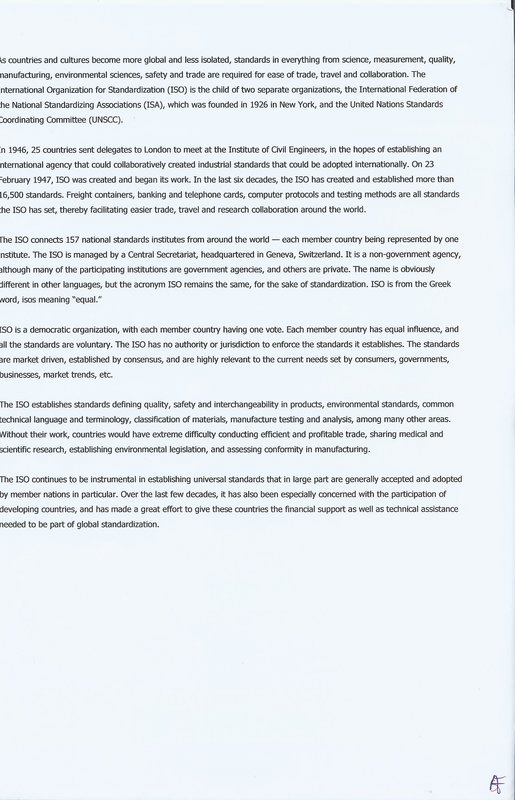indeks

is countries and cułtures beccroe morę global and less isolated, standards In everythmg from tdtncc, mcasurement, quality, nanufactunng, errvironmental Sciences, safcty and tradc arc rcguircd for casc of tradc, travcl and co&aboration. The nternational Organizabon for Słandardizabon (ISO) rs the chUd of two scporatc ocganirattons, the International Federation of he National Standardtong Assooatjons (ISA), wbkh was foundcd In 1926 In New York, and the United Nations Standards roordmatmg Commttee (UNSCC).
n 1946, 25 countnes sent deiegates to London to meet at the Institulc of CMI Engincers, In the hopes of estabtehmg an nternational agcncy that could cotoboratrreły ercated mdustrial standards that could bc adopted internationatty. On 23 fcbruary 1947, ISO was created and began ts work. In the last six decadcs, the ISO has crcated and establłshed morę than 16,500 standards. Frelght contamers, banking and tcłcphonc cards, Computer protocote and testmg methods are all standards he ISO has set, thereby faoMating easier tradc, travcl and rcscarch colaborabon around the worki.
rhe ISO connects 1S7 national standards institutes from around the worid — cach member country being represented by one nstitute. The ISO is managed by a Central Sccrctariat, headquartered in Gencva, Switrcrtand. It isa non-gowimment agency, ilthoogh many of the partiopating insttutions are government agenóes, and others arc prrvate. The name is obriously Jiffcrcnt in other tanguages, but the acronym ISO remains the same, for the sake of standarditałion. ISO is from the Greek wrd, eos meaning *cgual.'
ISO »s o democratic organizabon, with each member country having one vote. Each member country has egual influence, and 4 the standards are vofuntary. The ISO has no authonty or juńsdiction to cnforcc the standards it estabiishes. The standards irc market dnvcn, estabiished by consensus, and arc highly rekvant to the current needs set by consumers, governments, Ousmcsscs, market trcnds, etc.
The ISO estabiishes standards defining guality, safcty and mterchangeaWity in Products, enwronmental standards, common lechnical languagc and temunotogy, dassification of materiats, manufacture testing and anałysis, among many ckher areas. iVithout the» work, countries would have cxtreme difficulty conducting cRiocnt and profitabłe trade, sharing medkal and sbeotiFic rcscarch, estabkshing cnvvonmentai Icgislation, and assessing conformity in manufacturing.
The ISO contlnues to be instrumental in establishing unwersal standards that in large part are generally accepted and adopted by member nations in partiailar. Orer the last few decadcs, it has also becn especiaBy concemed with the parttópation of devcioping countries, and has madę a great effort to grve these countries the Financial support as well as technlcal assistance needcd to bc part of global standardizaten.
Wyszukiwarka